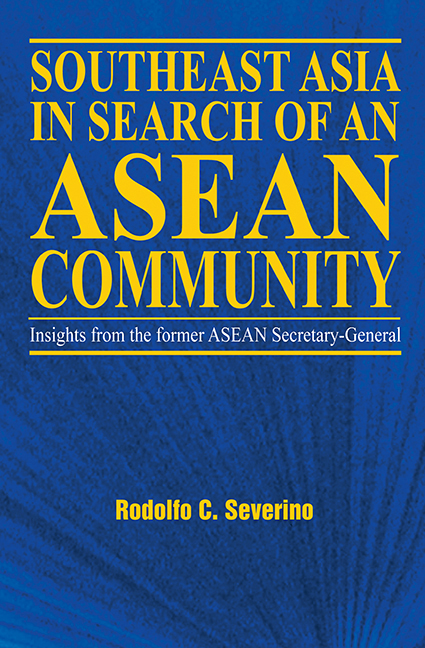Book contents
- Frontmatter
- Contents
- Foreword
- Introduction
- About the Author
- Acknowledgements
- Glossary
- 1 The “ASEAN Way”: Its Nature and Origins
- 2 Who Belongs in ASEAN? The Question of Membership
- 3 The Issue of Non-Interference
- 4 Regional Security: The ASEAN Role
- 5 Integrating the Regional Economy
- 6 ASEAN and the World
- 7 The ASEAN Community: Is It for Real?
- 8 What Kind of Future for ASEAN?
- Appendices
- A The ASEAN Declaration
- B Treaty of Amity and Cooperation in Southeast Asia
- C Agreement on the Common Effective Preferential Tariff Scheme for the ASEAN Free Trade Area
- D ASEAN Vision 2020
- E ASEAN at a Crossroads
- F Declaration of ASEAN Concord II
- G Recommendations of the High-Level Task Force on ASEAN Economic Integration
- H ASEAN Security Community Plan of Action
- I The ASEAN Socio-Cultural Community (ASCC) Plan of Action
- Interviews
- Index
D - ASEAN Vision 2020
from Appendices
Published online by Cambridge University Press: 21 October 2015
- Frontmatter
- Contents
- Foreword
- Introduction
- About the Author
- Acknowledgements
- Glossary
- 1 The “ASEAN Way”: Its Nature and Origins
- 2 Who Belongs in ASEAN? The Question of Membership
- 3 The Issue of Non-Interference
- 4 Regional Security: The ASEAN Role
- 5 Integrating the Regional Economy
- 6 ASEAN and the World
- 7 The ASEAN Community: Is It for Real?
- 8 What Kind of Future for ASEAN?
- Appendices
- A The ASEAN Declaration
- B Treaty of Amity and Cooperation in Southeast Asia
- C Agreement on the Common Effective Preferential Tariff Scheme for the ASEAN Free Trade Area
- D ASEAN Vision 2020
- E ASEAN at a Crossroads
- F Declaration of ASEAN Concord II
- G Recommendations of the High-Level Task Force on ASEAN Economic Integration
- H ASEAN Security Community Plan of Action
- I The ASEAN Socio-Cultural Community (ASCC) Plan of Action
- Interviews
- Index
Summary
We, the Heads of State/Government of the Association of Southeast Asian Nations, gather today in Kuala Lumpur to reaffirm our commitment to the aims and purposes of the Association as set forth in the Bangkok Declaration of 8 August 1967, in particular to promote regional cooperation in Southeast Asia in the spirit of equality and partnership and thereby contribute towards peace, progress and prosperity in the region.
We in ASEAN have created a community of Southeast Asian nations at peace with one another and at peace with the world, rapidly achieving prosperity for our peoples and steadily improving their lives. Our rich diversity has provided the strength and inspiration to us to help one another foster a strong sense of community.
We are now a market of around 500 million people with a combined gross domestic product of US$600 billion. We have achieved considerable results in the economic field, such as high economic growth, stability and significant poverty alleviation over the past few years. Members have enjoyed substantial trade and investment flows from significant liberalization measures.
We resolve to build upon these achievements.
Now, as we approach the 21st century, thirty years after the birth of ASEAN, we gather to chart a vision for ASEAN on the basis of today's realities and prospects in the decades leading to the Year 2020.
That vision is of ASEAN as a concert of Southeast Asian nations, outward looking, living in peace, stability and prosperity, bonded together in partnership in dynamic development and in a community of caring societies.
A Concert of Southeast Asian Nations
We envision the ASEAN region to be, in 2020, in full reality, a Zone of Peace, Freedom and Neutrality, as envisaged in the Kuala Lumpur Declaration of 1971.
ASEAN shall have, by the year 2020, established a peaceful and stable Southeast Asia where each nation is at peace with itself and where the causes for conflict have been eliminated, through abiding respect for justice and the rule of law and through the strengthening of national and regional resilience.
- Type
- Chapter
- Information
- Southeast Asia in Search of an ASEAN Community , pp. 411 - 415Publisher: ISEAS–Yusof Ishak InstitutePrint publication year: 2006

